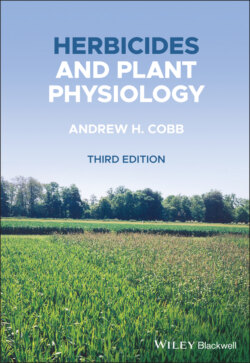Читать книгу Herbicides and Plant Physiology - Andrew H. Cobb - Страница 28
1.5.7 Dormancy and duration of viability
ОглавлениеAlthough the seed production figures of an individual plant are impressive (Table 1.9), the total seed population in a given area is of greater significance. The soil seed reservoir reflects both past and present seed production, in addition to those imported from elsewhere, and is reduced by germination, senescence and the activity of herbivores (Figure 1.3). Estimates of up to 100,000 viable seeds per square metre of arable soil represent a massive competition potential to both existing and succeeding crops, especially since the seed rate for spring barley, for instance, is only approximately 400 m−2! Under long term grassland, weed seed numbers in soil are in the region of 15,000–20,000 m−2, so conversion of arable land to long‐term grassland offers growers a means of reducing soil weed‐seed burden.
The length of time that seeds of individual species of weed remain viable in soil varies considerably. The nature of the research involved in collecting such data means that few comprehensive studies have been carried out, but those that have (see Toole and Brown, 1946, for a 39 year study!) show that although seeds of many species are viable for less than a decade, some species can survive for in excess of 80 years (examples include poppy and fat hen). Evidence from soils collected during archaeological excavations reveals seeds of certain species germinating after burial for 100–600 (and maybe even up to 1700!) years (Ødum, 1965).
Dormancy in weed seeds allows for germination to be delayed until conditions are favourable. This dormancy may be innate and contributes to the periodicity of germination, as illustrated in Figure 1.1. In addition, dormancy may be induced or enforced in non‐dormant seeds if environmental conditions are unfavourable. This ensures that the weed seed germinates when conditions are most conducive to seedling survival.
Figure 1.3 Factors affecting the soil seed population.
Source: Grundy, A.C. and Jones, N.E. (2002) What is the weed seed bank? In: Naylor, R.E.L. (ed.) Weed Management Handbook, 9th edn. Oxford: Blackwell Publishing/BCPC. Reproduced with permission of John Wiley & Sons.
